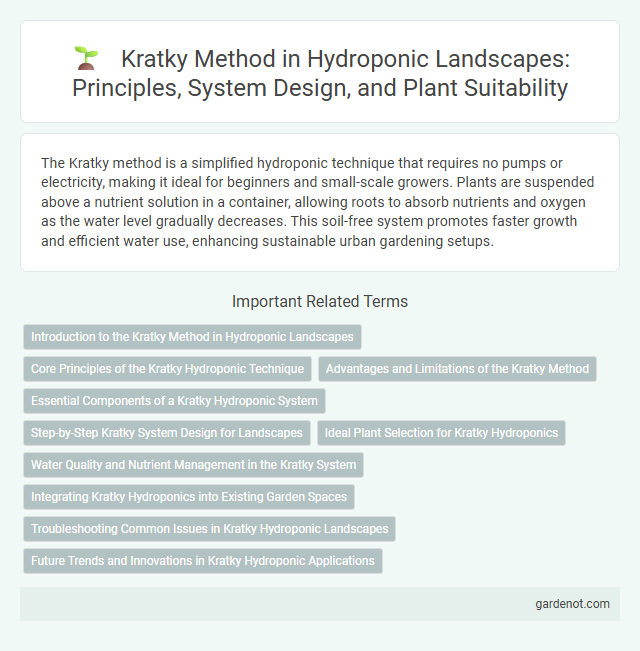The Kratky method is a simplified hydroponic technique that requires no pumps or electricity, making it ideal for beginners and small-scale growers. Plants are suspended above a nutrient solution in a container, allowing roots to absorb nutrients and oxygen as the water level gradually decreases. This soil-free system promotes faster growth and efficient water use, enhancing sustainable urban gardening setups.
Introduction to the Kratky Method in Hydroponic Landscapes
The Kratky method is a passive hydroponic technique widely used in hydroponic landscapes for its simplicity and efficiency. It eliminates the need for pumps or constant water circulation by suspending plant roots in a nutrient solution that gradually depletes as plants grow. This soil-free method supports sustainable and space-efficient greenery in urban and commercial hydroponic landscape designs.
Core Principles of the Kratky Hydroponic Technique
The Kratky hydroponic technique centers on a passive, non-circulating system where plant roots are suspended in a nutrient-rich water solution with an air gap allowing oxygen absorption. This method eliminates the need for pumps or aerators, reducing energy consumption and maintenance requirements. Nutrient depletion and oxygen availability naturally regulate plant growth, making it ideal for small-scale and low-cost hydroponic setups.
Advantages and Limitations of the Kratky Method
The Kratky method offers significant advantages such as simplicity, low cost, and minimal maintenance by eliminating the need for pumps or electricity, making it ideal for small-scale hydroponic setups. Its passive system design reduces water usage and risk of root oxygen deprivation compared to traditional hydroponic methods. However, limitations include limited scalability, lack of nutrient solution aeration over time, and vulnerability to rapid plant growth outpacing the static water and nutrient supply, which can restrict larger or commercial applications.
Essential Components of a Kratky Hydroponic System
The essential components of a Kratky hydroponic system include a nutrient reservoir, a growing container, and net pots to support the plants. The reservoir holds the nutrient solution, which supplies water and minerals directly to the plant roots suspended in the container without the need for pumps or aeration. An air gap between the nutrient solution and plant roots ensures oxygen availability, critical for healthy root development in the passive hydroponic setup.
Step-by-Step Kratky System Design for Landscapes
The Kratky method, a passive hydroponic technique, suits landscape design by requiring no pumps or electricity, making it ideal for sustainable and low-maintenance green spaces. To implement the system, begin by selecting suitable containers with opaque sides to prevent algae growth, then fill them with nutrient-rich water tailored to the specific plants used in the landscape. Ensure net pots hold the plants securely, with roots submerged in nutrient solution just below the water surface, and monitor water levels only periodically to maintain optimal growth conditions.
Ideal Plant Selection for Kratky Hydroponics
Ideal plant selection for Kratky hydroponics emphasizes leafy greens such as lettuce, spinach, and kale due to their shallow root systems and low nutrient demands. Herbs like basil, cilantro, and mint also thrive in this passive, non-circulating hydroponic method because they require minimal water aeration. Choosing crops with compact root zones and moderate growth rates ensures optimal nutrient absorption and water use efficiency in the Kratky system.
Water Quality and Nutrient Management in the Kratky System
Maintaining optimal water quality in the Kratky hydroponic system is critical for plant health, with parameters such as pH levels between 5.5 and 6.5 and electrical conductivity (EC) around 1.2 to 2.0 mS/cm ensuring efficient nutrient uptake. Consistent monitoring of dissolved oxygen and prevention of nutrient imbalances are essential, as stagnant water can lower oxygen availability, affecting root respiration. Proper management of the nutrient solution, including periodic adjustment of macronutrients like nitrogen, phosphorus, and potassium, supports sustained growth in the Kratky method without the need for active water circulation.
Integrating Kratky Hydroponics into Existing Garden Spaces
Integrating the Kratky hydroponic method into existing garden spaces maximizes crop yield without the need for pumps or electricity, making it ideal for sustainable urban gardening. Utilizing passive water and nutrient reservoirs allows plants to grow efficiently in compact areas such as balconies or indoor shelves, optimizing space and resources. This soil-free technique reduces pest risks and enables precise nutrient delivery, enhancing plant health and productivity in diverse garden environments.
Troubleshooting Common Issues in Kratky Hydroponic Landscapes
Troubleshooting common issues in Kratky hydroponic landscapes involves addressing nutrient imbalances, oxygen deficiencies, and water level mismanagement that can stunt plant growth. Monitoring pH levels between 5.5 and 6.5 is crucial to optimize nutrient uptake and prevent nutrient lockout. Ensuring the reservoir maintains an adequate air gap to provide roots with oxygen reduces the risk of root rot and promotes healthy development.
Future Trends and Innovations in Kratky Hydroponic Applications
Emerging trends in Kratky hydroponic applications emphasize automation and integration with IoT for real-time monitoring and nutrient management, enhancing crop yield and resource efficiency. Innovations include advanced biodegradable growth mediums and nutrient formulations tailored for specific crops, promoting sustainability and reducing environmental impact. Research into hybrid systems combining Kratky with aeroponics or aquaponics is expanding, aiming to optimize water use and diversify production capabilities in urban and resource-limited environments.
Kratky method Infographic

 gardenot.com
gardenot.com